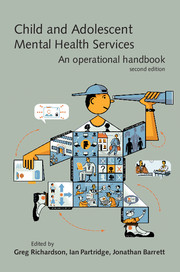Book contents
- Frontmatter
- Contents
- Tables, boxes and figures
- Contributors
- Abbreviations
- Preface
- 1 Introduction
- 2 CAMHS in context
- 3 CAMHS and the law
- 4 Structure, organisation and management of CAMHS
- 5 Evidence-based practice
- 6 Clinical governance
- 7 Education, supervision and workforce development
- 8 Multidisciplinary working
- 9 User and carer participation and advocacy
- 10 A comprehensive CAMHS
- 11 Referral management
- 12 Demand and capacity management
- 13 Strategies for working with Tier 1
- 14 Structuring and managing treatment options
- 15 CAMHS in the emergency department
- 16 Paediatric liaison
- 17 Self-harm
- 18 Learning disability services
- 19 Services for autism-spectrum disorders
- 20 Attentional problems services
- 21 Eating disorder teams
- 22 Bereavement services
- 23 CAMHS for refugees and recent immigrants
- 24 CAMHS and looked-after children
- 25 Drug and alcohol teams
- 26 Parenting risk assessment service
- 27 Court work
- 28 Tier 4 options
- 29 In-patient psychiatric care
- 30 Forensic services
- 31 Neuropsychiatry and neuropsychology services
- 32 Mental health provision for deaf children: study of a low-incidence service provision
- 33 Chief Executives – what do they want and how do they get it?
- Index
25 - Drug and alcohol teams
Published online by Cambridge University Press: 02 January 2018
- Frontmatter
- Contents
- Tables, boxes and figures
- Contributors
- Abbreviations
- Preface
- 1 Introduction
- 2 CAMHS in context
- 3 CAMHS and the law
- 4 Structure, organisation and management of CAMHS
- 5 Evidence-based practice
- 6 Clinical governance
- 7 Education, supervision and workforce development
- 8 Multidisciplinary working
- 9 User and carer participation and advocacy
- 10 A comprehensive CAMHS
- 11 Referral management
- 12 Demand and capacity management
- 13 Strategies for working with Tier 1
- 14 Structuring and managing treatment options
- 15 CAMHS in the emergency department
- 16 Paediatric liaison
- 17 Self-harm
- 18 Learning disability services
- 19 Services for autism-spectrum disorders
- 20 Attentional problems services
- 21 Eating disorder teams
- 22 Bereavement services
- 23 CAMHS for refugees and recent immigrants
- 24 CAMHS and looked-after children
- 25 Drug and alcohol teams
- 26 Parenting risk assessment service
- 27 Court work
- 28 Tier 4 options
- 29 In-patient psychiatric care
- 30 Forensic services
- 31 Neuropsychiatry and neuropsychology services
- 32 Mental health provision for deaf children: study of a low-incidence service provision
- 33 Chief Executives – what do they want and how do they get it?
- Index
Summary
‘Skunk … it only chills you out.’
14-year-old cannabis smoker
Why we need substance misuse services for youngPeople
Drug and alcohol services for young people have developed rapidly over the past decade in the UK (Crome, 1997; Gilvarry, 2000; Gilvarry & McArdle, 2007). In 1997, a task force was commissioned to review services for substance misuse in England (Department of Health, 1997). This work has culminated in national guidelines for the treatment of substance misuse (Department of Health, 2007; National Institute for Health and Clinical Excellence, 2007) and in the formation of the National Treatment Agency for Substance Misuse (NTA) which provides guidance on substance misuse specific to young people (National Treatment Agency for Substance Misuse, 2005, 2007, 2009a).
In the minds of both professionals and the public at large, substance use and subsequent misuse seem to have become ubiquitous. There have been other times when this was the case; however, features that are of contemporary relevance include:
• declining age of initiation into substance use
• multiple drug use
• prevalence of use by girls approaching that of boys
• widespread availability of illicit substances
• proposed link between substance misuse and an increased rate of completed suicide for men aged 15–24 years (Pelkonen & Marttunen 2003)
• widespread use of cannabis, stimulants and LSD within the dance/ rave culture
• the increased strength of current cannabis strains (skunk) through hybridisation and the probable link to the onset of schizophrenia (Arendt et al, 2005; Atakan, 2008)
• the increase in problematic alcohol use
• the decrease in numbers of young people using heroin and crack cocaine (National Treatment Agency for Substance Misuse, 2009b).
Many young people now are aware of psychoactive substances, know people who use them and use them themselves. The likelihood exists, therefore, of greater numbers of young people experiencing problems with substance use. Not surprisingly, young people whose development has already been compromised by a variety of adverse life events may initially find solace in substance use and later find themselves compounding their problems when the negative effects begin to accrue.
- Type
- Chapter
- Information
- Child and Adolescent Mental Health ServicesAn Operational Handbook, pp. 234 - 241Publisher: Royal College of PsychiatristsPrint publication year: 2010



